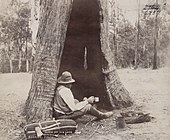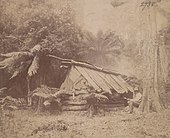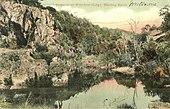Nicholas Caire
Nicholas Caire | |
|---|---|
 Cape Schanke and lighthouse, Flinders | |
| Born | Nicholas John Caire 28 February 1837 Guernsey, Channel Islands |
| Died | 13 February 1918 (aged 80) Armadale, Victoria, |
| Occupation | Photographer |
| Nationality | Australian |
| Spouse | Louisa Master |
Nicholas John Caire (28 February 1837 – 13 February 1918) was an Australian photographer.
Photography
At a young age Caire developed his passion for his photography and, with encouragement from his parents, he pursued this goal his entire life. Caire never pursued any other career goals that didn't include photography.
Until 1885, Caire specialized mostly in portrait photography, The development of the
He would only work with what he considered to be perfect conditions, this meant he would only take one or maybe two images a day, but because of the image quality in the work he would produce he could sell his works for a very high price and in large quantities. His best known series documented the rewards and hardships in the daily life of the first settlers.[2]
Exhibitions

Caire currently still has 5 artworks on display at the Art Gallery of New South Wales.[6] With a previous exhibition being held at the same place consisting of 32 artworks on display, the exhibition was titled Nicholas Caire.[7] At his Calcutta Exhibition Caire was awarded a prize for his images of the Melbourne Botanic Gardens.[3]
List of exhibitions
- Nicholas John Caire: photographer 1837–1918, at Art Gallery of New South Wales, Sydney, NSW, 1 November 1980 – 14 December 1980.
- Melbourne Centennial International Exhibition, at Exhibition Building, Melbourne, Victoria, 1888–1889.
- Calcutta, India, 1883–1884
- Melbourne International Exhibition, at Exhibition Building, Melbourne, 1880–1881.
- Sydney International Exhibition, at Garden Palace, Sydney, 1879–1880[8]
Death
Caire died on 13 February 1918.
References
- ISBN 978-0642081520.
- ^ a b c d e f g h i Cato, Jack. "Caire, Nicholas John (1837–1918)". Australian Dictionary of Biography. National Centre of Biography, Australian National University. Retrieved 24 March 2015.
- ^ a b c "Nicholas John Caire". Design and Art Australia Online. Design and Art Australia. Retrieved 15 April 2015.
- ^ S2CID 54517731.
- ^ a b Mccarthy, G.J. "Caire, Nicholas John". Encyclopedia of Australian Science. Retrieved 15 April 2015.
- ^ "Works matching "Nicholas Caire". Art Gallery of NSW. Retrieved 1 May 2015.
- ^ "Works Shown in the Exhibition 'Nicholas Caire'". Art Gallery of NSW. Retrieved 1 May 2015.
- ^ "Nicholas John Caire b. 1837 Guernsey, Channel Islands, UK". Design and Art Australia Online. Retrieved 1 May 2015.
- ^ Crombie, Isobel. "Framing Nicholas Caire, Fairy scene at the Landslip, Black's Spur c. 1878". National Gallery of Victoria. Retrieved 1 May 2015.




